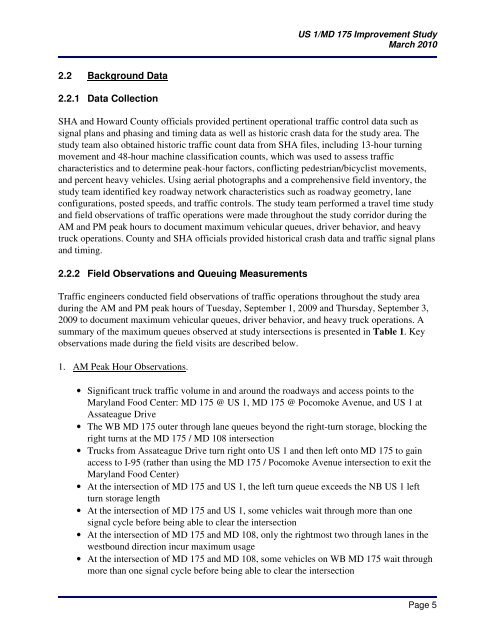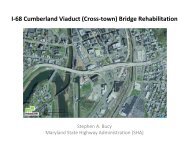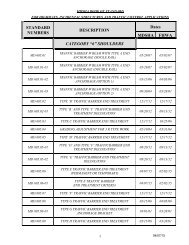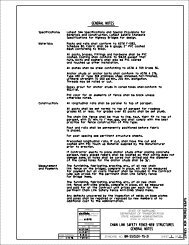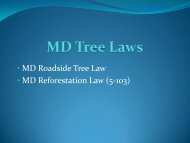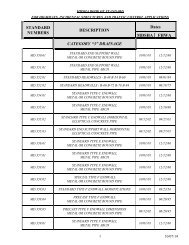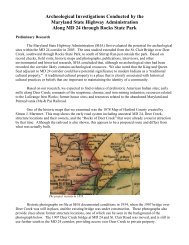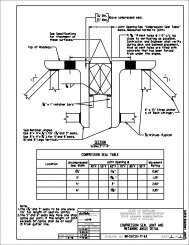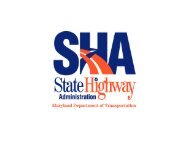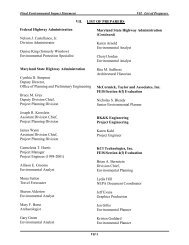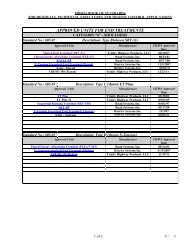US 1 / MD 175 Improvement Study Phase I Final Report March 2010
US 1 / MD 175 Improvement Study Phase I Final Report March 2010
US 1 / MD 175 Improvement Study Phase I Final Report March 2010
- No tags were found...
You also want an ePaper? Increase the reach of your titles
YUMPU automatically turns print PDFs into web optimized ePapers that Google loves.
<strong>US</strong> 1/<strong>MD</strong> <strong>175</strong> <strong>Improvement</strong> <strong>Study</strong><strong>March</strong> <strong>2010</strong>2.2 Background Data2.2.1 Data CollectionSHA and Howard County officials provided pertinent operational traffic control data such assignal plans and phasing and timing data as well as historic crash data for the study area. Thestudy team also obtained historic traffic count data from SHA files, including 13-hour turningmovement and 48-hour machine classification counts, which was used to assess trafficcharacteristics and to determine peak-hour factors, conflicting pedestrian/bicyclist movements,and percent heavy vehicles. Using aerial photographs and a comprehensive field inventory, thestudy team identified key roadway network characteristics such as roadway geometry, laneconfigurations, posted speeds, and traffic controls. The study team performed a travel time studyand field observations of traffic operations were made throughout the study corridor during theAM and PM peak hours to document maximum vehicular queues, driver behavior, and heavytruck operations. County and SHA officials provided historical crash data and traffic signal plansand timing.2.2.2 Field Observations and Queuing MeasurementsTraffic engineers conducted field observations of traffic operations throughout the study areaduring the AM and PM peak hours of Tuesday, September 1, 2009 and Thursday, September 3,2009 to document maximum vehicular queues, driver behavior, and heavy truck operations. Asummary of the maximum queues observed at study intersections is presented in Table 1. Keyobservations made during the field visits are described below.1. AM Peak Hour Observations.• Significant truck traffic volume in and around the roadways and access points to theMaryland Food Center: <strong>MD</strong> <strong>175</strong> @ <strong>US</strong> 1, <strong>MD</strong> <strong>175</strong> @ Pocomoke Avenue, and <strong>US</strong> 1 atAssateague Drive• The WB <strong>MD</strong> <strong>175</strong> outer through lane queues beyond the right-turn storage, blocking theright turns at the <strong>MD</strong> <strong>175</strong> / <strong>MD</strong> 108 intersection• Trucks from Assateague Drive turn right onto <strong>US</strong> 1 and then left onto <strong>MD</strong> <strong>175</strong> to gainaccess to I-95 (rather than using the <strong>MD</strong> <strong>175</strong> / Pocomoke Avenue intersection to exit theMaryland Food Center)• At the intersection of <strong>MD</strong> <strong>175</strong> and <strong>US</strong> 1, the left turn queue exceeds the NB <strong>US</strong> 1 leftturn storage length• At the intersection of <strong>MD</strong> <strong>175</strong> and <strong>US</strong> 1, some vehicles wait through more than onesignal cycle before being able to clear the intersection• At the intersection of <strong>MD</strong> <strong>175</strong> and <strong>MD</strong> 108, only the rightmost two through lanes in thewestbound direction incur maximum usage• At the intersection of <strong>MD</strong> <strong>175</strong> and <strong>MD</strong> 108, some vehicles on WB <strong>MD</strong> <strong>175</strong> wait throughmore than one signal cycle before being able to clear the intersectionPage 5


